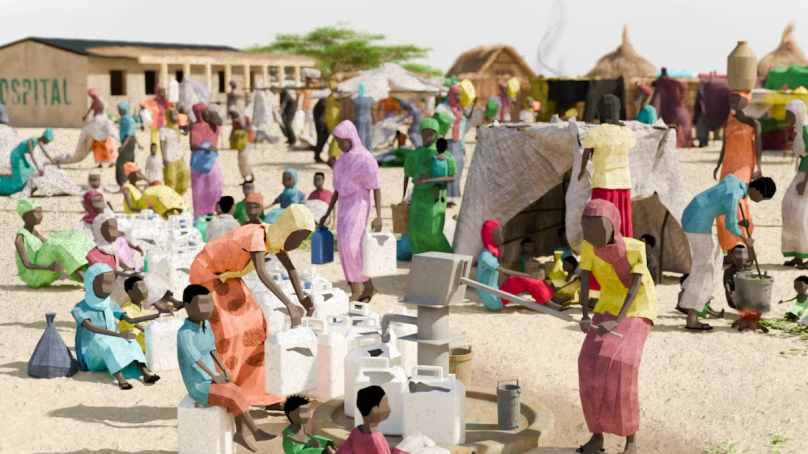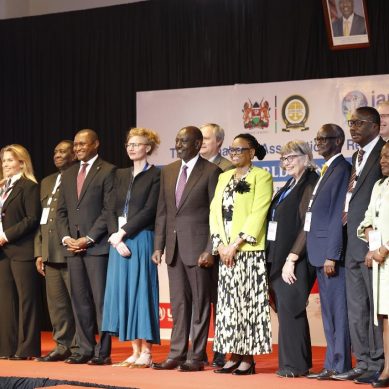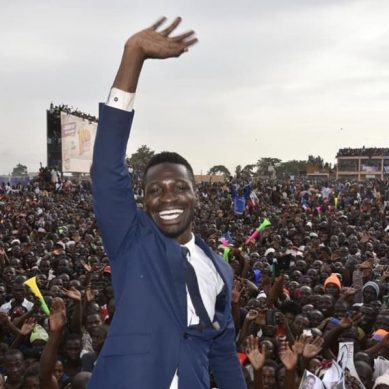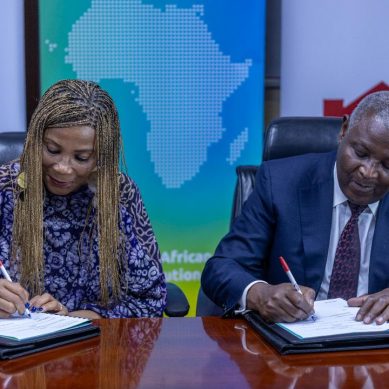
Twenty years ago, Somalia was headed for catastrophe. Conflict, drought and government collapse threatened to plunge 200,000 people into famine.
But relief groups lacked enough food for everyone and had no consistent way of identifying those most at risk of starvation. A man angered about his clan’s limited share of food aid fired shots at humanitarian workers.
Nicholas Haan, an American then working on the aid effort for the United Nations, had an idea: Create an evidence-driven system that objectively classified acute food insecurity and engaged both international experts and Somali leaders so all agreed on how to manage the crisis.
The idea worked, Haan said. Locals helped gather evidence for the analysis. That led to greater acceptance of tough decisions on where to send aid, he said.
The process Haan and other aid workers sketched out in about a month eventually evolved into the Integrated Food Security Phase Classification or IPC, a global partnership that’s a linchpin in today’s vast system for monitoring and alleviating hunger. It is designed to sound the alarm about developing food crises so organisations can respond and prevent famine and mass starvation.
Phases of food insecurity
The IPC’s five-phase classification system charts food insecurity in more than 35 developing nations on a progressive scale, from minimal at Phase 1 to famine at Phase 5. Aid is meant to flow to hunger-stricken areas during the early phases, to ward off food emergencies and famine.
But as hunger crises sweep parts of the developing world this year, the technocratic assumptions on which the IPC warning system rests are colliding with messy and brutal realities. In March, the IPC warned that famine was imminent in northern Gaza. In August, it said famine had taken hold in part of Sudan’s North Darfur state.
Nevertheless, UN officials said in early November that the entire population of northern Gaza was at “imminent risk of dying from disease, famine and violence.” In Darfur, little aid has reached Zamzam, a famine-stricken camp for displaced people and its estimated 500,000 residents are at risk of dying of hunger-related causes.
Critically, the IPC is struggling to access the data it needs to conduct informed analyses. With most of the world’s food crises being driven by conflict, it has become increasingly difficult to gather the information the IPC requires to classify vulnerable nations on its five-stage acute food-security scale.
In Gaza, Israeli bombing and restrictions on movement have impeded efforts to collect statistics on malnutrition, deaths unrelated to trauma and other essential data. In Sudan, violence, military roadblocks, bureaucratic obstruction and a telecommunications blackout have disrupted efforts to test for malnutrition, count deaths and survey people about their access to food.
“The single largest driver of hunger in the world is conflict. This means that people who are most desperately in need are in the hardest-to-reach areas.”
Another frequently false assumption underpinning the IPC’s work: The world will respond promptly to its warnings. In reality, significant aid sometimes comes after the starving are already dying in droves.
Perhaps the system’s greatest weakness – one its creator Haan points to himself – is the premise that governments in hunger-stricken countries will cooperate fully with the IPC, the UN and other outside helpers.
Government involvement can be the system’s greatest strength, Haan said, empowering countries to solve their own problems. But it was realised that giving local officials a seat at the table – as the IPC usually does – also can pose a conflict of interest, positioning them to undermine the hunger monitor’s work and harming the people it is meant to protect. This is especially true in cases of civil war, when a government’s military strategy can trump humanitarian goals.
“It inadvertently gives a veto to any belligerent party that does not want a famine declared,” said Jeremy Konyndyk, president of the humanitarian relief group Refugees International and former director of the Office of US Foreign Disaster Assistance in the US Agency for International Development.
In three countries now suffering severe food crises, it was found that governments or rebels have blocked or falsified the flow of data to the IPC or have tried to suppress its findings.
In Ethiopia, the government disliked an IPC finding that 350,000 people were experiencing catastrophic acute food insecurity – so it stopped working with the IPC. In Yemen, Houthi rebels commandeered the IPC’s research process and exaggerated a food crisis to try to get more aid. In Sudan, the government tried to invalidate a survey that showed high rates of acute malnutrition among children. Ethiopian and Sudanese officials said the IPC analyses were flawed. Houthi representatives said their research documented a legitimate humanitarian crisis.
$15 billion
One reason for such sabotage: Governments fear the international stigma and domestic political blowback from being unable to perform one of their most basic duties: feeding their own people.
“Countries don’t want to be told they’re presiding over a famine,” said Mark Lowcock, who coordinated UN emergency relief efforts from 2017 to 2021. “It does not win you international kudos and admiration. So these state entities try to wiggle and weave to avoid having that exposed.”
The IPC acknowledges that the impediments sometimes slow its work and delay alerts seeking urgently needed resources for places with extreme hunger crises. That is one reason for new protocols the IPC announced November 22.
IPC Global Programme Manager Jose Lopez, in response to questions about the warning system’s shortcomings, said the IPC will now require that its technical experts take over government-headed analyses within two weeks of when evidence points to famine and there are exceptional circumstances, such as government interference or delay. The IPC said the change is intended to ensure timely, unbiased reports during crises, in hopes of halting mass starvation and preventing widespread deaths.
In October, the IPC also issued new guidance on how analysts should incorporate conflict conditions into their reports. The guidance cites the IPC’s failure to warn early enough that South Sudan seemed headed for famine in 2020. Armed militias were fighting over resources and historic grievances, displacing tens of thousands of people. Analysts hadn’t adequately factored in the impact of the organised violence on food security, the document says. The guidance directs analysts to consider ways conflict can drive food insecurity, such as cutting access to food, causing prices to skyrocket and disrupting crop production.
An examination of how the IPC operates and whether it is an effective alert system is based on internal IPC documents and communications, meeting minutes of humanitarian organisations and data on aid delivery, nutrition and donations. Reporters also interviewed dozens of aid workers, government officials, IPC analysts and academics who study food security.
Many of the problems plaguing the IPC are beyond its control, from civil war and other conflicts that obstruct data collection to tardy reactions to its forecasts by aid donors and distributors. The IPC says its hunger analyses help direct $6 billion in annual aid to the more than 35 nations it monitors. But $15 billion of requests for food security and nutrition globally went unmet in 2023, according to US data that tracks the flow of aid.
Martin Griffiths, who stepped down as UN humanitarian relief chief in June, said shortages of data, money and access to areas where people are starving has created a situation in which “your hands are tied behind your back from the beginning.”
The UN’s own internal weaknesses also can hamper relief efforts. In Ethiopia, massive amounts of aid from the UN’s World Food Program (WFP) were diverted, in part because of the organisation’s lax administrative controls. An internal WFP report on Sudan identifies a range of problems in the organisation’s response there, including an inability to react adequately to the crisis, missed funding opportunities and what it describes as “anti-fraud challenges,” it was reported on Wednesday.
The hunt for data
Today, the IPC is an independent body funded by Western nations and overseen by 19 large humanitarian organisations and intergovernmental institutions. Although its duties are far-reaching, its resources are tight: It has just 60 paid staff and an $8.5 million annual budget. It relies on hundreds of analysts from governments and partner agencies to produce reports on hunger and acute malnutrition in Africa, Asia, Latin America and the Middle East.
IPC reports rank areas for acute food insecurity on a one-to-five scale that slides from minimal to stressed, crisis, emergency and famine.
In each country, a “technical working group,” usually headed by the national government, analyses data, classifies areas on the IPC scale and issues periodic reports. Rather than gathering its own data, the IPC relies on the WFP, a multi-billion-dollar global distributor of food aid, and other relief organisations and government agencies to provide it.
When famine is in play, the group’s analysis often gets another layer of scrutiny – from the IPC’s five-member Famine Review Committee, which vets and verifies the finding. The IPC’s hunger analyses require rigorously examining data on factors scientifically linked to food security, such as crop yields, food prices and malnutrition.
Although those uniform standards and technical rigor are important, it is essential that they don’t become a barrier or slow the process of delivering aid, said Deepmala Mahla, chief humanitarian officer for the relief organisation CARE, an IPC partner.
“The single largest driver of hunger in the world is conflict,” Mahla said. “This means that people who are most desperately in need are in the hardest-to-reach areas. The single most pressing IPC challenge is the difficulty in collecting mortality and nutrition data from these areas.”
- A Reuters report








